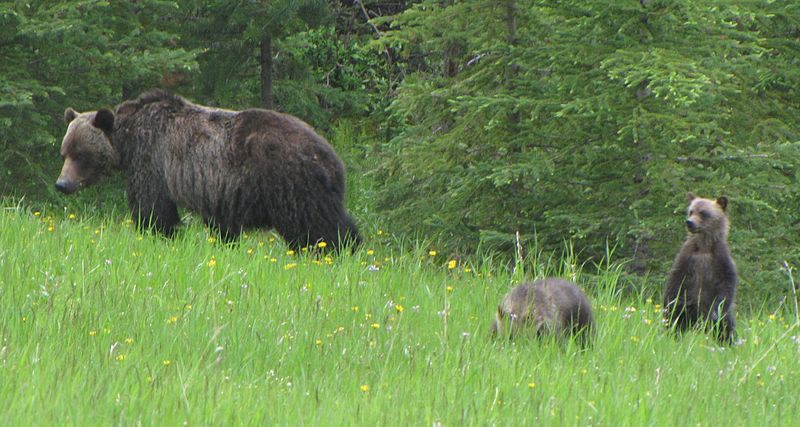Reproduction
Grizzly bears use the process of sexual reproduction to expand
their species. During the
mating season for grizzly bears, usually between June and July,
grizzly bears will seek one another out to mate.
Once mating happens, the bears will go their separate
ways. Unlike most animals
whose embryos begin to develop right away, a grizzly bear embryo
will not begin to develop for until around six months after
mating. The reason for
this is because if the female grizzly bear has not accumulated
enough winter fat to sustain herself, and also the potential
cubs she would have, the embryo doesn't develop.
If the embryo does develo p, the cubs are usually born in
January, during hibernation.
A female bear usually has between one to three cubs that
weigh around one pound (U.S. Department of the Interior, 1995).
The cubs stay alive by drinking milk from the mother and
staying warm from her body heat.
By the time the mother bear and cubs come out of the den,
the cubs weigh around twenty pounds.
The cubs survive on the mother’s milk for about one year.
After that, they begin to feed on what adult grizzly
bears feed on, such as plants, animals, and fish.
They stay with the mother until they are three to four
years old. After they
leave the mother, they begin their own life and try to find a
mate to breed with. Only
about fifty percent of all bear cubs reach breeding age, which
is around 4.5 to 5.5 years old (U.S. Department of the Interior,
1995). The mortality rate
is so high because of a multiple of factors.
Some of these include predation from other bears and
wolves, traffic accidents, lack of food, and abandonment by the
mother.
p, the cubs are usually born in
January, during hibernation.
A female bear usually has between one to three cubs that
weigh around one pound (U.S. Department of the Interior, 1995).
The cubs stay alive by drinking milk from the mother and
staying warm from her body heat.
By the time the mother bear and cubs come out of the den,
the cubs weigh around twenty pounds.
The cubs survive on the mother’s milk for about one year.
After that, they begin to feed on what adult grizzly
bears feed on, such as plants, animals, and fish.
They stay with the mother until they are three to four
years old. After they
leave the mother, they begin their own life and try to find a
mate to breed with. Only
about fifty percent of all bear cubs reach breeding age, which
is around 4.5 to 5.5 years old (U.S. Department of the Interior,
1995). The mortality rate
is so high because of a multiple of factors.
Some of these include predation from other bears and
wolves, traffic accidents, lack of food, and abandonment by the
mother.
